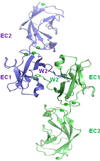Cross talk between focal adhesion kinase and cadherins: role in regulating endothelial barrier function
- PMID: 21864544
- PMCID: PMC3427140
- DOI: 10.1016/j.mvr.2011.08.001
Cross talk between focal adhesion kinase and cadherins: role in regulating endothelial barrier function
Abstract
A layer of endothelial cells attached to their underlying matrices by complex transmembrane structures termed focal adhesion (FA) proteins maintains the barrier property of microvascular endothelium. FAs sense the physical properties of the extracellular matrix (ECM) and organize the cytoskeleton accordingly. The close association of adherens junction (AJ) protein, cadherin, with the cytoskeleton is known to be essential in coordinating the appropriate mechanical properties to cell-cell contacts. Recently, it has become clear that a crosstalk exists between focal adhesion kinase (FAK) and cadherin that regulates signaling at intercellular endothelial junctions. This review discusses recent advances in our understanding of the dynamic regulation of the molecular connections between FAK and the cadherin complex and cadherin-catenin-actin interaction-dependent changes as well as the role of small GTPases in endothelial barrier regulation. This review also discusses how a signaling network regulates a range of cellular processes important for barrier function and diseases.
Copyright © 2011 Elsevier Inc. All rights reserved.
Figures





Similar articles
-
Regulation of reactive oxygen species-induced endothelial cell-cell and cell-matrix contacts by focal adhesion kinase and adherens junction proteins.Am J Physiol Lung Cell Mol Physiol. 2005 Dec;289(6):L999-1010. doi: 10.1152/ajplung.00211.2005. Epub 2005 Jul 22. Am J Physiol Lung Cell Mol Physiol. 2005. PMID: 16040628
-
Neutrophil transmigration, focal adhesion kinase and endothelial barrier function.Microvasc Res. 2012 Jan;83(1):82-8. doi: 10.1016/j.mvr.2011.06.015. Epub 2011 Aug 16. Microvasc Res. 2012. PMID: 21864543 Free PMC article. Review.
-
Dynamic Regulation of Vascular Permeability by Vascular Endothelial Cadherin-Mediated Endothelial Cell-Cell Junctions.J Nippon Med Sch. 2017;84(4):148-159. doi: 10.1272/jnms.84.148. J Nippon Med Sch. 2017. PMID: 28978894 Review.
-
Role of FAK in S1P-regulated endothelial permeability.Microvasc Res. 2012 Jan;83(1):22-30. doi: 10.1016/j.mvr.2011.08.012. Epub 2011 Sep 5. Microvasc Res. 2012. PMID: 21925517 Free PMC article. Review.
-
Focal adhesion kinase and endothelial cell apoptosis.Microvasc Res. 2012 Jan;83(1):56-63. doi: 10.1016/j.mvr.2011.05.003. Epub 2011 May 19. Microvasc Res. 2012. PMID: 21624380 Free PMC article. Review.
Cited by
-
Focal adhesion kinase-Tyr407 and -Tyr397 exhibit antagonistic effects on blood-testis barrier dynamics in the rat.Proc Natl Acad Sci U S A. 2012 Jul 31;109(31):12562-7. doi: 10.1073/pnas.1202316109. Epub 2012 Jul 12. Proc Natl Acad Sci U S A. 2012. PMID: 22797892 Free PMC article.
-
FVIII regulates the molecular profile of endothelial cells: functional impact on the blood barrier and macrophage behavior.Cell Mol Life Sci. 2022 Feb 21;79(3):145. doi: 10.1007/s00018-022-04178-5. Cell Mol Life Sci. 2022. PMID: 35190870 Free PMC article.
-
Role of Neutrophil Extracellular Traps and Vesicles in Regulating Vascular Endothelial Permeability.Front Immunol. 2019 May 9;10:1037. doi: 10.3389/fimmu.2019.01037. eCollection 2019. Front Immunol. 2019. PMID: 31143182 Free PMC article. Review.
-
Regulatory pathways affecting vascular stabilization via VE-cadherin dynamics: insights from zebrafish (Danio rerio).J Cereb Blood Flow Metab. 2014 Sep;34(9):1430-3. doi: 10.1038/jcbfm.2014.128. Epub 2014 Jul 16. J Cereb Blood Flow Metab. 2014. PMID: 25027310 Free PMC article. Review.
-
Extracellular matrix in the trabecular meshwork: intraocular pressure regulation and dysregulation in glaucoma.Exp Eye Res. 2015 Apr;133:112-25. doi: 10.1016/j.exer.2014.07.014. Exp Eye Res. 2015. PMID: 25819459 Free PMC article. Review.
References
-
- Abercrombie M, Dunn GA. Adhesions of fibroblasts to substratum during contact inhibition observed by interference reflection microscopy. Exp Cell Res. 1975;92:57–62. - PubMed
-
- Abercrombie M, et al. The locomotion of fibroblasts in culture. IV. Electron microscopy of the leading lamella. Exp Cell Res. 1971;67:359–367. - PubMed
-
- Aberle H, et al. Assembly of the cadherin-catenin complex in vitro with recombinant proteins. J Cell Sci. 1994;107(Pt 12):3655–3663. - PubMed
-
- Al-Amoudi A, Frangakis AS. Structural studies on desmosomes. Biochem Soc Trans. 2008;36:181–187. - PubMed
-
- Anastasiadis PZ, Reynolds AB. The p120 catenin family: complex roles in adhesion, signaling and cancer. J Cell Sci. 2000;113(Pt 8):1319–1334. - PubMed
Publication types
MeSH terms
Substances
Grants and funding
LinkOut - more resources
Full Text Sources
Research Materials
Miscellaneous

